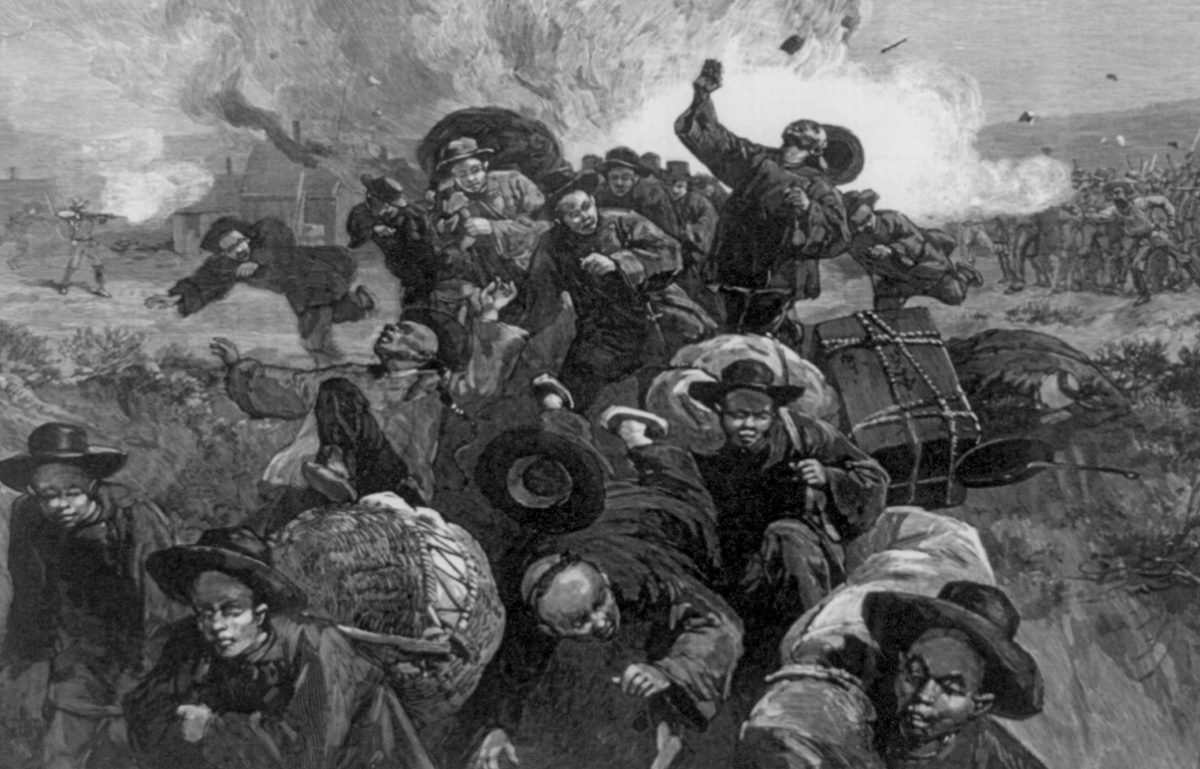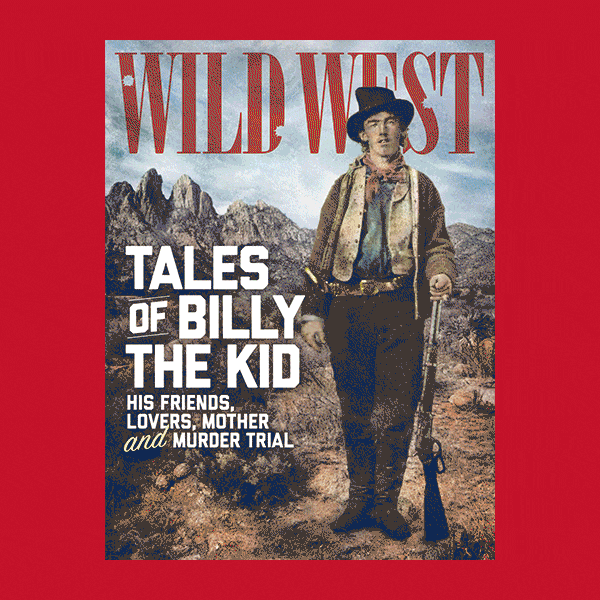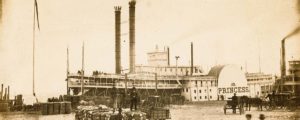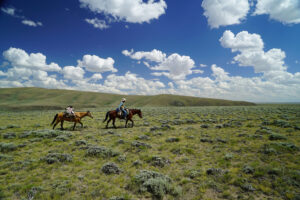Gong Heng San had not slept for two days. Neither had the 36 other Chinese laborers hired by L. A. and Ingelbricht Wold to pick the hops on their farm just outside a little town called Squak in King County, Washington Territory.
The sleeplessness of Gong Heng San and friends was understandable; it’s difficult to rest comfortably with the threat of mob violence looming over you.
The Saturday night of the workers’ arrival, a crowd of armed men had confronted the Wolds and told them to expel the Chinese from their farm.
“I shall either die or the Chinamen shall go,” Henry Tibbetts, one of the members of the crowd, had angrily told L. A. Wold.
The next night, the workers’ sleep was disturbed by reports that a second group of Chinese laborers on their way to join their countrymen at the Wolds’ farm had been turned back at gunpoint by an angry mob.
The Wolds notified the district attorney’s office in Seattle of impending violence. J. T. Ronald, the D.A., wired George Tibbetts, a Squak merchant and the local justice of the peace, for his assessment of the situation.
“I don’t think their [sic] will be any trouble in our little valley,” Tibbetts wrote back. “Their [sic] was a little disturbance at the China Camp I am told, but as near as I can find out about it — it was just for a little fun. Law and order would be maintained,” Tibbetts said.
The Wolds passed on these promises to their workers. Relieved and reassured, the weary men turned in early on the night of Monday, September 7, 1885.
At about 9:30 that evening, a group of 10 to 12 men opened fire on the Chinese camp. It sounded like a China New Years, Gong Heng San said later. So many firecrackers. The Chinese fled in panic, while the mob unsuccessfully tried to burn their tents.
When Gong Heng San and a handful of the workers returned about 15 minutes later, they found their compatriot Fung Wue dead from a gunshot to the chest. A gut-shot Mong Gow lived an agonizing half-hour before he, too, died. Yeng San, wounded in the left arm and in both legs, lingered painfully through the evening.
“I’ll die sure,” Yeng San told Gong Heng San. “I am sorry. Got a son home. Too young. No one to send him money.”
Come morning, Yeng San was also dead. The rest of the workers elected to return to the relative safety of Seattle.
Gong Heng San called it the night white men came to kill Chinamen, but the mob included more than white men. In a rare instance of Indian-white cooperation, several local Indians joined the attack on the Chinese.
Their reason? They resented the competition from Chinese labor. Hop growers in Washington Territory had typically hired Indians to pick their crop, and now Indians and whites found common ground in their fear that low-wage Chinese labor would take away their jobs.
Prejudice against chinese prevalent
Only about 105,000 Chinese resided in the United States at the time of the shootings, but their presence aroused a great deal of prejudice, particularly in the West, where their numbers were highest. About three-fourths of the total Chinese population lived in California, with most of the rest scattered through Oregon, Idaho, Nevada, and Washington Territory. In Washington, the Chinese numbered just shy of 3,200 out of a total population of 67,199.
Since their first arrival on Western shores in the 1860s, the Chinese had been greeted with violence by the resident Americans. In 1871, massive anti-Chinese riots convulsed Los Angeles and San Francisco, and during the Great Railway Strike of 1877, mobs burned 25 Chinese businesses in San Francisco. Denver saw a wave of anti-Chinese disturbances in 1880. And in 1885, just five days before the Squak incident, white miners rioted against the presence of Chinese laborers in Rock Springs, Wyoming Territory.
The violence at Squak differed from these other incidents because of the Indians’ participation. By 1885, the Indians of western Washington Territory no longer depended solely on hunting, fishing and gathering for their food. Nor did they receive government rations the way some reservation-bound tribes in other parts of the country did. Many of them lived off the reservations and worked for wages, a necessity because white settlers had disrupted their traditional ways of getting food. Indians worked in lumber camps, sawmills and mines, as well as in the settlers’ houses and fields.
The boom in hops growing, which took hold in the 1880s, gave Indians another potential source of cash income. In fact, by 1885, the hops harvests had become grand get-togethers for Indians all over the Northwest — a time not just for work but also for socializing. Three days after the shootings at Squak, for example, one observer found 1,000 Indian pickers — including British Columbia Indians, Flatheads and a large camp of Klickitats from east of the [Cascade] mountains — encamped at a hop ranch in Snoqualmie, north of Seattle.
The extremely low market price for hops in 1885, however, had goaded the Wold brothers into replacing their Indian pickers with Chinese. The Indians had been promised $1 per box, according to one newspaper account, but the Wolds wanted to get their crop in more cheaply. It was generally understood, the report stated, that the Indians would refuse to accept the reduction. The Wolds had therefore contacted a Chinese labor contractor in Seattle to provide them with a replacement work force. One Seattle newspaper described the shootings as the War of the Wages.
Word of the shootings spread quickly among the locals, who had little liking for the Chinese. A jury of inquiry was hastily impaneled by none other than George Tibbetts, the local justice of the peace, who had pooh-poohed the possibility of violence. This jury rapidly issued its official verdict: the Chinese men had died at the hands of persons unknown.
Tibbetts’ effort to sweep the case under the rug failed when an 18-year-old laborer named Sam Robertson admitted to Ronald, the King County district attorney, that he and several other men had taken part in the shootings. On October 7, with the help of Robertson’s testimony, Ronald got a grand jury to indict seven men, including two Indians, for murder.
Young man testifies to shootings
Recommended for you
Robertson said that about 7:30 the night of the killings, Tibbetts had stepped out of his store and fired eight shots into the air. This signal prompted the gathering of seven men, including Robertson and Perry Bayne, a local blacksmith whom Robertson named as the ringleader of the group. Each of the men carried a weapon, and Tibbetts furnished them with ammunition.
At about 8:30, the men left Tibbetts’ store and proceeded to the neighboring Indian camp. As Robertson was the only one who spoke and understood Chinook jargon, the pidgin trade language that allowed whites and Indians to communicate, he was appointed to recruit the Indians. Robertson, Bayne, and Daniel Hues visited the tents of three Indians: Jim Graham, Indian Curley and Indian Johnny. The Indians were reluctant to join in, but a combination of threats and persuasion finally convinced them to take part. According to Jim Graham, the whites had told the Indians that if they did not come along on the attack, the white men would shoot them.
The group, now grown to 10, continued on their way. A number of curious onlookers, both white and Indian, joined them, swelling the crown to about 20 people. Robertson led the way, as he was the most familiar with the area.
“After going half a mile,” Robertson later testified, “we stopped and agreed to stay together. If any man ran away and left the others, he was to be shot.” Several men left the group at this point.
The Chinese encampment on the Wolds’ farm sat on a little peninsula formed by a creek that ran on the property. The group of armed men approached it from the south. They crossed through a gap in the fence and closed in on the first tent.
“Hold up the tent and all shoot when we get ready,” commanded Bayne.
As the group surrounded the tent, Robertson saw a flash from a rifle some 60 to 75 yards in front of them. At the same instant, Bayne gave the order to fire, and the group riddled the tent with bullets. When the firing stopped, one member of the group turned to Bayne.
“What do we do now, Perry?” he asked.
“Dry up your damned mouth,” Bayne responded. “Don’t call my name. Everybody knows me here.”
Robertson testified that his gun jammed after the first round. When he told Bayne his gun was broken, Bayne snapped, “Never mind the gun; start pulling down the tents.”
After a halfhearted effort to burn the tents (everything was wet because of the autumn rains typical of Washington), the men hurried from the camp and quickly walked home, swearing not to talk to anyone about the evening’s events.
What role did the Indians play in all of this? Jim Graham said the Indians fled when the shooting started. Robertson and Bayne also seemed to exonerate the Indians from any part in the actual shooting. Bayne said the white men would have been afraid to trust the Indians.
The whites may have gotten the Indians involved because they wanted scapegoats in case something went wrong. Graham initially refused to testify in the case because he was afraid it was a way for the whites to lay the blame on the Indians for killing the Chinese men.
Judge condemns lawless violence
Once it became clear that white men had done the shooting, public opinion in the territory made clear its support of the attackers’ ends, if not their means. The Seattle Daily Post-Intelligencer editorialized that “a fair trial and just punishments were needed if respect for the law is to be maintained among our people, and if the fair reputation of Washington Territory is to be preserved.” But the newspaper also went on to say: “The people of King County may be said to be unanimous in their recognition of the evils entailed by the employment of Chinese contract labor. They approve of any honest, fair, and manly movement designed to relieve American laborers of Chinese competition.”
The judge in the case, Roger Greene, made the same distinction between means and ends. Born in Boston in 1840, Greene had come west in 1870 to serve as a district judge. He had logged an extraordinary 15 years on the territorial bench, the longest of any territorial district judge. An ordained Baptist minister, a dedicated Republican and a social reformer, Greene was probably the pre-eminent jurist in Washington Territory.
In a case ostensibly about murder, however, Greene went out of his way to make clear his own sentiments about the Chinese. In an address to the grand jury, Greene stated that he shared the prevalent conviction of the people that the Chinese are out of place in America and “their presence is an obstacle to its highest business prosperity.”
But Greene stressed the difference between the desire to be rid of the Chinese and the recourse to violence to achieve that goal. No matter how the jurors felt about the Chinese, he told them, a resort to lawless violence to promote their removal is utterly inexcusable. “That prosperity so threatened by Chinese labor,” Greene said, “will be scattered to the four winds if this county is to be published to the world as the place to which social agitators can safely resort to try their experiment of mob law.”
Two days after the grand jury indicted the suspects, Greene rewarded Robertson for his testimony before the grand jury. He discharged Robertson and barred any further trial of him because of his cooperation as a witness. Robertson had betrayed his friends so that he could go free.
verdict comes within a day
The trial started on October 28. Robertson was the star witness, but the prosecution also called two Indians and two Chinese to the witness stand.
The defense immediately objected to the testimony of Gong Heng San: How could a non-Christian Chinese man understand an oath to tell the truth, much less the significance of placing his hand upon a Bible?
Gong Heng San said he knew the sanctity and binding force of an oath, and that he believed in the God he had been taught about in the schools he had attended in America. He said he had never seen a Chinese person swear on the bloody head of a chicken or by the burning of paper, and he swore he did not worship the idols or gods of China.
GET HISTORY’S GREATEST TALES—RIGHT IN YOUR INBOX
Subscribe to our HistoryNet Now! newsletter for the best of the past, delivered every Monday and Thursday.
He seems to be a convert, the defense attorney admitted, and withdrew his objection to Gong Heng San’s testimony.
The first witnesses merely set the stage for Robertson, who had been laid low by typhoid fever for three weeks prior to the trial. He came to the witness stand attended by his doctor, and again testified that Bayne and the other defendants were at the Chinese encampment with guns blazing on Monday night.
The defense attacked him as a liar, calling witnesses who contradicted portions of Robertson’s story, especially regarding who was present at Tibbetts’ store immediately before the shooting and how many guns were available. The day after Robertson left the witness stand, the man who had shared his jail cell told one of the defense attorneys that Robertson had admitted he lied. While in jail, Robertson had told his cell mates that George Tibbetts hd not furnished any ammunition that night, but that he was going to stick to the story to get himself out of the fix in which he was, and then get out of the country.
Robertson is here working for the territory in order to save his own neck, the defense told the jury. The defense also called Robertson a hothead and the real ringleader of the attack. Two defense witnesses testified to Robertson’s own vehement anti-Chinese feeling. The night before the shootings, one witness recalled, Robertson had launched into a tirade against the Chinese, branding the white men in the valley a bunch of cowards. “If I could get a few men to follow me I would go up and kill every one of them,” Robertson reportedly said.
Robertson, the defense concluded, was an impetuous young fellow who had read a great many novels of blood-curdling incidents, who wanted to be a leader and do some daring deeds.
Meanwhile, a parade of character witnesses testified to the good reputation of Bayne and the other defendants. No one, it seemed, had ever seen Bayne commit a violent act or say one word against the Chinese. The defense said that rather than being the ringleader of the attack, as the prosecution maintained, Robertson had only gone along with the crowd to try to dissuade the other men from violence.
The defense also made much of Robertson’s statement that the first flash of gunfire had come from the direction of the Chinese camp. Rather than an unprovoked attack, the whites had simply returned fire in self-defense, the attorneys argued. The last weapon in the defense’s arsenal was to shift the blame away from the men who had attacked the Chinese and toward the true culprits: the Wolds.
The Wolds had triggered the conflict, the argument went, by bringing in the Chinese workers. The settlers around Squak depended on the hop industry for their livelihood. They did not object to Indian labor because the wages were spent in the community. But by bringing in the Chinese, the Wolds had tried to introduce a class of labor that on account of its cheapness was objectionable to a greater class of the citizens of the valley.
Moreover, the Wolds had intended hop-picking to be only an entering wedge for the Chinese. With a lot of land to be cleared, the Wolds clearly intended to wreck the whole local economy by replacing white (and Indian) labor wholesale with cheap labor, the defense argued.
Who was telling the truth? After four days of testimony before a packed courthouse, it was up to the jury to decide. Judge Greene told the jurors that even if they were not sure who had fired any of the fatal shots, the defendants were legally guilty if they had aided and abetted in the killings. He also reminded them that “a Chinaman, upon our soil… stands before the law, just as any other man would, with the same rights to life and limb and property… as any one of our own citizens.”
The jury did not deliberate long. They returned with their verdict the very same day. Not guilty. The anti-Chinese feelings of the jurors, combined with the uncertainty over exactly who had fired the fatal shots and the defense’s planting of the idea that the shootings might have been in self-defense, had derailed the prosecution’s case.
But District Attorney Ronald had one more trick up his sleeve. If not guilty of murder, perhaps the defendants could be found guilty of riot, meaning a violent disturbance of the peace. Ronald tried the same seven men, plus George Tibbetts, on this new charge, which included not only the shootings on Monday night but also the confrontation at the Wolds’ farm on Saturday night.
Since most of the defendants had already confessed to participating in the Saturday night incident, the prosecutor’s job was easier. On November 23, the jury returned a guilty verdict. A week later, the penalty was imposed: a $500 fine. The lives of three Chinese men, apparently, came quite cheap. Not cheap enough, however. The defendants appealed their conviction to the Territorial Supreme Court. Their appeal rested on the fact that women had been included on the grand jury that had handed down the indictments. The women were not qualified grand jurors, the appeal charged, so the indictments were invalid.
Retrial ordered but never happened
The appeal came before the Supreme Court in January 1888. The court had just invalidated a law giving women the vote, saying it violated the territorial Organic Act, the founding law of Washington Territory. Now, the court reasoned, if women were not entitled to vote, how could they be entitled to sit on grand juries, especially since the law required all grand jurors to be heads of household and qualified voters? They could not, the court decided, and so every indictment handed down by a grand jury with a female member was invalid.
The case against the rioters was returned to the lower court for retrial. But a retrial never occurred. After the passage of so many years and with the disappointing results from the earlier trials, the prosecutor doubtless thought the chances for a conviction were slim. And so the matter ended, at least in the eyes of the law.
But the incident at Squak only foreshadowed larger anti-Chinese demonstrations in the months to come. Mass meetings against Chinese labor were held in the cities of Seattle and Tacoma during the trial of the Squak defendants. The day after the acquittal of the defendants, a movement led largely by labor organizations expelled the Chinese population of Tacoma beyond the city limits. Most of the Chinese population of Seattle was also kicked out of the city, despite the arrival of federal troops to maintain order and protect the Chinese.
Indians continued to pick the hops and perform other forms of manual labor for Washington’s farmers until well into the 20th century. Only when a blight destroyed large parts of the local hops industry in the 1920s did hops picking cease to be an important source of Indian employment.
As for the individual defendants in the Squak cases, no one can know for sure if the men fingered by Robertson were the actual guilty parties. Although they were no friends to the Chinese workers, they were not necessarily murderers. But whoever killed those three Chinese men at Squak, they got away with it. As happened so often in the West, the long arm of the law did not reach very far.
This article was written by Brad Asher and originally appeared in Wild West.
historynet magazines
Our 9 best-selling history titles feature in-depth storytelling and iconic imagery to engage and inform on the people, the wars, and the events that shaped America and the world.








